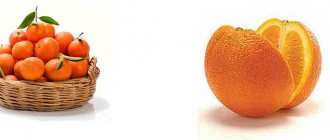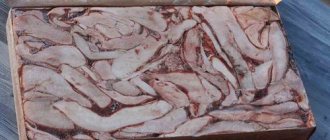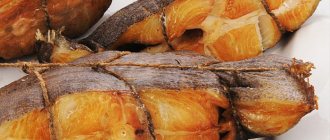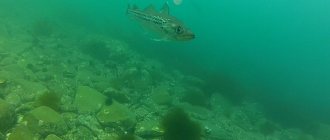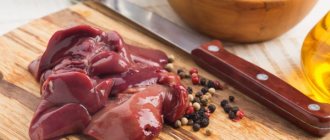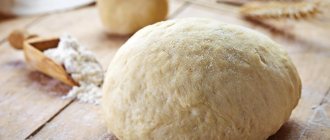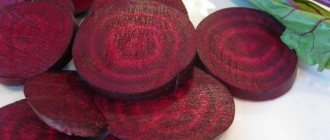Sea bass is widely used in Japanese cuisine, where it is the basis for many traditional dishes. But in Russia, the meat of this deep predator is no less in demand, which is due to its rich biochemical composition and high nutritional value: a full complex of vitamins, polyunsaturated omega-3 acids, protein, amino acids, protein. Along with this, fish is low in calories and is easily digestible. Therefore, dishes made from it will be desirable in every person’s diet. They are especially indicated for pregnant women, children and the elderly.
- Baked in foil
Description
Sea bass belongs to the scorpionfish family from the order Perciformes. Compared to its river relatives, it looks much larger. The size of the carcass can reach 1 m and weigh more than 10 kg. It depends on the species. The color also differs, but red is more often sold. The Japanese call this fish "mebaru", which refers to its huge bulging eyes. It is by this feature and sharp fins that this representative can be recognized.
There are up to 90 varieties of sea bass, but the most commercially available are beaked, white, golden, and stone. They live in the cold waters of the Atlantic and Pacific Oceans, and are sometimes found in the waters of Northern Norway.
The meat is considered a delicacy, as it has a delicate and rich taste. The carcasses have a pleasant white-pink hue. Fish is often sold in cut form: frozen, smoked or salted. You can prepare many tasty and healthy dishes from sea bass; it can be stewed, baked, fried, salted, boiled, smoked.
The benefits and harms of sea bass
Eating and cooking perch is associated with certain risks, in particular, the high selenium content, if consumed in excess, can lead to deterioration in the health of hair, skin, and other undesirable consequences.
The meat of this fish (per 100 g) contains many vitamins, such as:
- A – 15 mcg (1.7% of the daily value), with vitamin deficiency, night blindness and dry eyes develop.
- B1 – 0.04 mg (3.8%), vitamin deficiency threatens brain damage.
- B4 – 78.6 mg (15.7%), vitamin deficiency threatens gastritis, increased blood pressure, and arrhythmia may also occur.
- B12 – 1.7 mcg (71.7%), vitamin deficiency threatens increased fatigue and memory impairment.
- D – 1.4 mcg (9.3%), with a deficiency, rickets and destruction of bone tissue develop.

- D3 – 1.4 mcg (8.6%), with vitamin deficiency, rickets and osteoporosis develop, and the risk of cancer and cardiovascular diseases increases.
- E – 0.9 mg (6.2%), vitamin deficiency threatens diseases of the nervous and muscular systems and anemia.
- RR – 1.2 mg (7.6%), with vitamin deficiency, pellagra develops (disorder of the digestive system and skin lesions).
Sea bass (the benefits and harms of introducing this fish into the diet are determined by its composition) contains taurine. This is a special acid that contains sulfur and stimulates brain activity. Its deficiency negatively affects the state of vision and the nervous system.
On the other hand, as a result of increasing levels of mercury pollution in the ocean, dishes made from this fish should be consumed with caution. In addition, the species “sea perch” belongs to the “scorpion fish” family, therefore, sharp spines connected to poisonous glands are hidden in their fins. An injection from such a thorn when processing fish in the kitchen can cause inflammation or an allergic reaction.
Calories and nutritional value
Sea bass fillet is valued for its rich and unique composition. It contains:
- vitamins: groups B, A, E, PP, D;
- micro- and macroelements: phosphorus, iodine, cobalt, magnesium, iron, selenium, potassium and others;
- polyunsaturated omega-3 fatty acids;
- amino acids;
- protein;
- taurine;
- antioxidants.
Depending on the species, the calorie content per 100 grams of fresh product varies from 100 to 190 kcal. The energy value is high. Composition of BJU: proteins - 16-18 g, fats - 4-11 g, carbohydrates - less than 0.1 g.
Number of calories and nutritional value of fish of different cooking methods:
| View | Calorie content, kcal | Proteins, g | Fats, g | Carbohydrates, g |
| Hot smoked | 167 | 23,4 | 8,1 | 0 |
| Cold smoked | 87 | 17,3 | 2 | 0 |
| Boiled | 111 | 15,1 | 3,7 | 0,2 |
| Fried | 138 | 17,1 | 4,9 | 2,1 |
| Baked in the oven | 120 | 18 | 4 | 0,3 |
How to reduce calories?
Raw sea bass contains 79 kcal per 100 g. Cold smoked sea bass has a calorie content of 88 kcal. If you boil 100 g of sea bass, its energy value will be 112 kcal, and if you fry it - 137.

Sea perch, the benefits and harms of which depend on the method of preparation, undergoes minimal heat treatment when smoked. Processing products with smoke is harmful because they carry the risk of infections and parasitic diseases, for example, opisthorchiasis. In addition, benzopyrene, a carcinogenic substance, accumulates in products.
Smoked products also contain a lot of table salt, the use of which disrupts the mineral balance of the body, leaching calcium, magnesium and potassium. On the other hand, as a result of cold smoking, a larger percentage of useful substances remains in the fish - essential amino acids, vitamins - B12, B6, E, D, A; fish oil, minerals.
The most harmless way to reduce the calorie content of sea bass is steaming - per 100 g of product the calorie content is 104 kcal, while minimizing the likelihood of the harmful effects of infections, carcinogens and excessive consumption of table salt.
The most effective and harmless way to reduce the calorie content of perch is to prepare a complex dish from it, for example, celery soup with sea bass meat. The calorie content of such a dish per 100 g will be 44 kcal.
Beneficial features
The value of red perch for the human body is due to its rich chemical composition. List of useful properties:
- lowers the level of “bad” cholesterol, which protects against the development of atherosclerosis;
- prevents hypoxia;
- controls blood sugar;
- has a positive effect on the thyroid gland;
- serves as a prevention of diseases of the cardiovascular, nervous and digestive systems;
- enhances metabolism and cleanses of waste and toxins, which promotes weight loss;
- reduces blood pressure;
- improves hematopoiesis;
- normalizes vision.
Meat is indicated for inclusion in the daily diet in case of physical and nervous exhaustion, as well as after serious illnesses and operations. Children need it to prevent rickets and as a source of vitamins and fatty acids. In the absence of medical contraindications for pregnant women, seafood is important for maintaining good health and full development of the fetus. It is noted that with regular consumption of fish during this period, children are born healthier and smarter.
One of the valuable components in the product is taurine, the effect of which is equivalent to drug therapy. Its lack in the body entails irreversible changes in the brain, impairs vision and negatively affects the psychological background.
Regular consumption of sea bass helps restore the structure of the skin and returns it to a healthy appearance. Hair becomes shiny and silky, and nails become strong. This is especially important for women, for whom such a nutritional supplement will serve as an anti-aging agent.
Which perch is healthier?
According to scientific research, it is better to eat fish caught from its natural habitat. This is explained by a higher content of beneficial omega-3 acids than in those grown artificially.
This may be due to differences in diet. The wild predator feeds on plankton, which produces polyunsaturated fats. On fish farms, fish are fed mainly with compound feed, and algae is rarely given.
How it is used in dietetics and for weight loss
Sea bass (the benefits and harms of inclusion in the dietary menu are determined by its energy value) is a dietary low-calorie product. Eating sea bass dishes prevents diseases associated with the cardiovascular system, atherosclerosis, heart attack, and stroke.
The body of people who regularly consume moderate amounts of this product is less susceptible to thrombosis, loss of vision, sudden jumps in blood pressure and metabolic disorders. As a result of the introduction of this product into the diet, the health of the skin, nails, tooth enamel, bone structure, and hair improves.
Sea bass is considered a dietary product; it acts as a substitute for high-calorie sources of protein - meat and fatty fish.
A diet for the purpose of losing weight (in the absence of allergies and individual intolerance to seafood, in particular this fish) should include reasonable amounts of low-calorie dishes from sea bass, the pleasant taste of which increases motivation for losing weight.
Potential dangers and contraindications
Harm from sea bass is possible if it lived in environmentally unfavorable waters: in this case, the carcasses are saturated with heavy metals, mercury and become infected with dangerous parasites. Therefore, pregnant women and children should introduce fish into their diet with extreme caution and buy it only from trusted suppliers.
Despite its great benefits, perch fillet has a number of contraindications for consumption. These include:
- gout;
- excess calcium in the body;
- stones in the kidneys;
- individual intolerance to individual components in the composition;
- allergies to fish and seafood;
- oncology.
When purchasing refrigerated red snapper fillets, you may encounter a stale product, since it is transported from afar. It is important to pay attention to the appearance of the carcasses and the smell. The presence of gray gills and cloudy eyes is unacceptable, which indicates staleness. Pressing on the meat should not leave any dents.
Another danger comes from the fins, which have a toxic substance at the tips. If it gets under the skin, it can cause severe inflammation. Therefore, you should wear gloves when cleaning to avoid damaging your hands.
Recommendations for use
The fish product tolerates any thermal effect well, without losing its beneficial and taste qualities. There are many culinary recipes with sea bass. It is stewed, pickled, baked, fried, smoked, boiled or steamed. The last 2 options are recommended for children, pregnant and breastfeeding women, and the elderly. It is advisable to eat fish dishes three times a week and in the morning.
A healthy and safe daily portion of fish for an adult is 120-140 g. For children, this figure varies depending on age: up to 3 years - 25-30 g, 3-6 years - 50-60 g, 7-14 - 70- 80 g. Since perch meat is not bony, it can be ground into a puree for babies and given as complementary food from 10 months.
In many weight loss diets, low-fat fish are included in the permitted diet . In terms of nutritional value, this product surpasses even pork. When creating a dietary menu, you should adhere to some recommendations:
- Take into account the compatibility of fish with vegetables. The most acceptable: carrots, greens, all types of cabbage, beets, peppers, tomatoes. Potatoes and radishes are excluded.
- Fillet is exclusively stewed, boiled or baked. It is unacceptable to eat it salted, smoked or fried.
- It is advisable not to add salt to the dishes, but you can add lemon juice.
Due to the presence of proteins, amino acids and protein in perch, there is no loss of muscle mass. Saturation occurs quickly and for a long time, without the deposition of extra calories.
Application
Good taste, dense meat and high content of vitamins and microelements make sea bass universal for preparing first and second courses, appetizers, aspic and other culinary masterpieces. Released during the heat treatment of dams, it is a sticky substance, thanks to which it is possible to obtain delicious aspic dishes. An excellent aromatic fish soup is prepared from perch. And in production, a lot of shelf-stable by-products are prepared from fish.
Market Analytics
- Black Lives Matter movement: reaction and consequences for the beauty industry
- COVID-19 is changing the rules of the game in the cosmetics market
- Beauty of the future: cosmetic innovations 2021
Convenient search for beauty salons on our website
Beauty salons in Moscow Beauty salons in St. Petersburg Beauty salons in Ekaterinburg Beauty salons in Novosibirsk
Latest blog posts on our website
- Naturecream / Tremella Extract - Snow Mushroom Detox for Skin
- Prostye-sovety / How to visually enlarge your lips with makeup
- Naturecream / Apricot kernel oil for face
- Naturecream / MATRIXYL3000 - the best skin elasticity stimulator
- Naturecream / SPF in Natural Oils
- Naturecream / Geranium (Pelargonium) oil for skin health and beauty
- Prostye-sovety / Save on a beauty salon: procedures that can be done at home
- Naturecream / Growth Factor - brings back youth?
- Oksana-Lezina / 3 effective abdominal exercises from a fitness instructor for beginners
- Prostye-sovety / Making perfect curls at home
Latest forum topics on our website
- Natalya / How to properly make a gelatin mask?
- Mrs._Smith / Badly sunburned! What to do?((
- Ice / Is it necessary to combine fitness classes with a diet?
- Antonova / What can be used for hair loss?
- Radio operatorKat / Who was on a protein diet?
Other articles in this section
| Pressed sturgeon caviar The number of fish of the sturgeon family on our planet is rapidly declining. Since the beginning of this century, Russian legislation has prohibited fishing for this most valuable fish in Russia. Already more than 10 species of the family are classified as rare. As a result, Canada and America took first place in sturgeon production. In Russia, special fish farms are being created where sturgeon are grown, but so far this is too little. But black caviar is a unique product, very important for all humanity. |
| Poached river perch In Russia, the habitat of this fish extends quite widely from the Black Sea river basin, the North Caucasus, to the coastal rivers of the Arctic Ocean. The population size allows it to be considered an important commercial target. A predator that eats everything that moves is able to quickly increase its numbers after being caught. The perch is armed with sharp spines on its fins and shield plates. The scales are small and dense, which creates certain difficulties when cleaning the fish. |
| Canned cod caviar Many food products in the modern world are canned, and cod caviar is not an exception, but rather a pattern. After all, caviar is a perishable product and cannot be stored for a long time without proper “care.” At the same time, all useful vitamins and microelements are retained in the canned product if preparation standards are met and approved ingredients are used. |
| Fried sturgeon Sturgeon belongs to the fish that are considered the most ancient on Earth. Scientists have a lot of evidence that this type of fish lived during the existence of dinosaurs. Representatives of sturgeon live in Asia, Europe, and North America. But the largest number is found in the Russian seas - the Caspian, Azov and Black. There are quite a lot of this fish in the Ob, Volga, Lena, Kolyma, Amur rivers, and Lake Baikal. Some specimens have an average length of up to 2 meters and a weight of 50 to 80 kg. The meat of any type of sturgeon is tender and tasty. There are many recipes for cooking, but it is especially tasty fried or baked. |
| Salted herring Salted herring is a product that is a frequent guest on any table. It can be used not only on holidays (nowadays not a single feast would be complete without salted herring), but also on ordinary everyday life. It serves as an appetizer or as an ingredient in a variety of salads and dishes. In the modern world there is no need to cut herring. After all, ready-made fish fillets can be found in any store, presented in the form of preserves and canned food. |
| Grilled cod Cod belongs to the cod family. Fish are found in salt and fresh waters. There are 100 different species in this family. Atlantic cod can reach a length of up to two meters. The cod that is fished for reaches 40–80 cm. It is greenish-olive in color and feeds on crustaceans for up to three years. Further food for cod is capelin and herring. For example, the Canadian government has banned fishing for it, as the species is close to extinction. |
| Boiled salmon Salmon is a fish from the salmon family, which has a large mass and length. Salmon can be found in the Baltic Sea, Arctic and Atlantic oceans. This is the most valuable fish for fishing, since its meat is highly valued in all countries of the world due to its taste characteristics and beneficial properties. Boiled salmon retains the maximum amount of useful elements in its composition. |
| Ide Ide is a very common type of fish of the carp family. It lives in freshwater bodies of water and is occasionally found in slightly saline waters of sea bays. Prevails in rivers, lakes and reservoirs throughout Europe with the exception of its southeastern part. Prefers to live in quiet, deep rivers, avoiding fast cold currents. Under favorable temperature and natural conditions, it grows up to 75 cm in length and weighs from 500g to 3kg. Particularly large ides weighing 10 kg are often found. |
| White Amur White Amur got its name from the place where this fish is found in large quantities, namely in the Amur River. Belongs to the carp family. Can reach up to 120 centimeters in length. The weight of the fish is also quite significant - it can reach up to 32 kilograms. Becomes ready for spawning at 8-9 years. One adult fish can lay up to 1 million eggs and begins to spawn at a temperature of 26 degrees Celsius. White Cupid is a herbivorous fish, eating only plants. |
| Atlantic sardine with added oil Sardine is a marine fish that lives mainly in the Atlantic Ocean and the Mediterranean Sea. Belongs to the herring family, small in size - depending on the species, it can be from 15 to 25 centimeters. Fish gather in schools, the length of which can reach several kilometers, and move in search of food. The scales of a live sardine shimmer in different colors - silver, blue, green. |
Perch recipes
Before cooking, red snapper is cleaned and cut into portions. The whole carcass is often baked in the oven. To prevent the meat from falling apart and burning during frying, it is first marinated for about half an hour in a mixture of special herbs and spices. To do this, you can buy them or use your favorite ones from your own supplies.
To preserve the juicy structure in the finished state, it is recommended to roll fish pieces in flour, breadcrumbs, semolina or corn flakes before frying. A very tasty dish is made in batter, for which eggs and flour are mixed.
Baked in foil

Perch baked in the oven in foil turns out tasty and aromatic, with a pleasant crispy crust.
Required Products:
- perch carcasses - 2 pcs. ;
- Parmesan cheese - 150 g;
- tomatoes - 2–3 pcs.;
- sweet pepper - 1 pc.;
- onion - 1 head;
- garlic - 2-3 cloves;
- sour cream - 120 g;
- greens - for decoration;
- salt, ground pepper - to taste.
Cooking sequence:
- The fish is washed under running water.
- Vegetables are cut into arbitrary shapes, greens are finely chopped with a knife.
- The cheese is rubbed with shavings.
- The carcass is salted and peppered inside and out. Place on a sheet of food foil.
- Vegetable preparations and finely chopped garlic are placed nearby, poured with sour cream and sprinkled with cheese and herbs.
- Roll it up into a bag and put it in the oven to bake. At a temperature of +190...+200 degrees, this takes about an hour.
- 10 minutes before the end, open so that a golden crust appears on top.
Fried
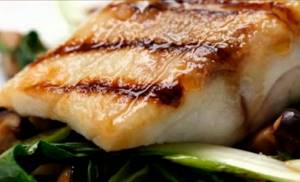
Pan-fried, breaded perch will be a tasty and satisfying dinner or lunch. To do this you will need the following composition:
- fish - 600–700 g;
- lemon - 1/4 part;
- refined sunflower oil - 2-3 tbsp. l.;
- basil, lettuce leaves - for decoration;
- breadcrumbs - 2 tbsp. l.;
- wheat flour - 20 g;
- salt, fish seasoning - to taste.
Process:
- After washing, fish carcasses are lightly dried on paper towels.
- Rub with salt and spices. Drizzle with freshly squeezed lemon juice.
- Roll first in flour, then in breadcrumbs.
- Fry in a hot frying pan with a little oil. Keep on each side for 2-3 minutes until golden brown.
Place the finished fish on lettuce leaves and garnish with basil sprigs, which will add a special aroma to the dish. Additionally, you can serve any sauce and fresh vegetables.
